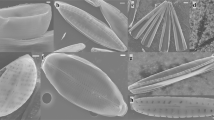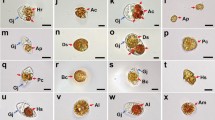Abstract
The marine diatoms Phaeodactylum tricornutum and Thalassiosira pseudonana have been shown to produce apo-fucoxanthinoid compounds which act as feeding deterrents against the harpacticoid copepod Tigriopus californicus. The amounts and types of apo-fucoxanthinoids produced were species specific. Th. pseudonana produced small quantities of apo-12′-fucoxanthinal and apo-13′-fucoxanthinone only during senescence, while P. tricornutum produced much greater quantities of these two compounds during both log and senescence phases, in addition to producing a third compound, apo-10-fucoxanthinal, only during senescence. For both species, production of apo-fucoxanthinoids increased as the cells entered senescence phase due to phosphate limitation. The amounts of apo-fucoxanthinoids necessary to reduce feeding in T. californicus by 50% ranged from 2.22 to 20.2 ppm. This range was approximately 1000 times lower than the total apo-fucoxanthinoid concentration in P. tricornutum. The amounts of apo-fucoxanthinoids necessary to cause a 50% mortality in a population of T. californicus ranged from 36.8 to 76.7 ppm. Thus, these compounds are present in concentrations which may have ecological significance in the control of bloom formation and grazing. The production of apo-fucoxanthinoids may be a phenomenon common to many diatoms, particularly as they enter senescence due to nutrient limitation.
Similar content being viewed by others
References
Ali RM (1970) The influence of suspension density and temperature on the filtration rate of Hiatella arctica. Mar Biol 6: 291–302
Boyer GL, Sullivan JJ, Andersen RJ, Harrison PJ, Taylor FJR (1985) Toxin production in three isolates of Protogonyaulax sp. In: Anderson DM, White AW, Baden DG (eds) Toxic dinoflagellates. Elsevier, New York, NY, pp 281–286
Boyer GL, Sullivan JJ, Andersen RJ, Harrison PJ, Taylor FJR (1987) Effects of nutrient limitation on toxin production and composition in the marine dinoflagellate Protogonyaulax tamarensis Mar Biol 96: 123–128
Carlsson P, Graneli E, Olsson P (1990) Grazer elimination through poisoning: one of the mechanisms behind Chrysochromulina polylepis blooms? In: Graneli E et al. (eds) Toxic marine phytoplankton. Elsevier, New York, NY, pp 116–122
Chotiyaputta C, Hirayama K (1978) Food selectivity of the rotifer Brachionus plicatilis feeding on phytoplankton. Mar Biol 45: 105–111
Craigie JS, McLachlan J (1964) Excretion of colored ultravioletabsorbing substances by marine algae. Can J Bot 42: 23–33
Davis CO, Harrison PJ, Dugdale RC (1973) Continuous culture of marine diatoms under silicate limitation. I. Synchronous life cycle of Skeletonema costatum. J Phycol 9: 175–180
Egloff DA (1986) Effects of Olisthodiscus luteus on the feeding and reproduction of the marine rotifer Synchaeta cecilia. J Plankton Res 8: 263–274
Gross J (1991) Pigments in vegetables: chlorophylls and carotenoids. Van Nostrand Reinhold, New York, NY, pp 75–99
Hansen PJ (1989) The rat tide dinoflagellate Alexandrium tamarense: effects on behaviour and growth of a tintinnid ciliate. Mar Ecol Prog Ser 53: 105–116
Hansen PJ, Cembella AD, Moestrup O (1992) The marine dinoflagellate Alexandrium ostenfeldii: paralytic shellfish toxin concentration, composition, and toxicity to a tintinnid ciliate. J Phycol 28: 597–603
Harrison PJ, Waters RE, Taylor FJR (1980) A broad spectrum artificial seawater medium for coastal and open ocean phytoplankton. J Phycol 16: 28–35
Haugan JA, Liaaen-Jensen S (1989) Improved isolation procedures for fucoxanthin. Phytochemistry 28: 2797–2798
Huntley ME (1982) Yellow water in La Jolla Bay, California, July 1980. II. Supression of zooplankton grazing. J exp mar Biol Ecol 63: 81–91
Huntley M, Sykes P, Rohan S, Marin V (1986) Chemically-mediated rejection of dinoflagellate prey by the copepods Calanus pacificus and Paracalanus parvus: mechanism, occurrence, and significance. Mar Ecol Prog Ser 28: 105–120
Lewin JC (1958) The taxonomic position of Phaeodactylum tricornutum. J gen Microbiol 18: 427–432
Reguera B, Oshima Y (1990) Responses of Gymnodinium catenatum to increasing levels of nitrate: growth patterns and toxicity. In: Graneli E, et al. (eds) Toxic marine phytoplankton. Elsevier, New York, NY, pp 316–319
Reish DL, Oshida PS (1987) Manual of methods in aquatic environmental research. Part 10: short-term static bioassays. FAO Fish Tech Pap 247: 1–62
Shaw BA, Andersen RJ, Harrison PJ (1995) Feeding deterrence properties of apo-fucoxanthinoids from marine diatoms. I. Chemical structures of apo-fucoxanthinoids produced by Phaeodactylum tricornutum Mar Biol 124: 467–472
Shaw BA, Harrison PJ, Andersen RJ (1994) Evaluation of the copepod Tigriopus californicus as a bioassay organism for the detection of chemical feeding deterrents produced by marine phytoplankton. Mar Biol 121: 89–95
Sykes PF, Huntley ME (1987) Acute physiological reactions of Calanus pacificus to selected dinoflagellates: direct observations. Mar Biol 94: 19–24
Targett NM, Ward JE (1991) Bioactive microalgal metabolites: mediation of subtle ecological interactions in phytophagous suspension-feeding marine invertebrates. Bioorg mar Chem 4: 91–118
Tracey G, Steele R, Wright L (1990) Variable toxicity of the brown tide organism, Aerococcus anophagefferens, in relation to environmental conditions for growth. In: Graneli E et al. (eds) Toxic marine phytoplankton. Elsevier, New York, NY, pp 233–237
Trick CG, Andersen RJ, Harrison PJ (1984) Environmental factors influencing the production of an antibacterial metabolite from a marine dinoflagellate, Prorocentrum minimum. Can J Fish aquat Sciences 41: 423–432
Uye S, Takamatsu K (1990) Feeding interactions between planktonic copepods and red-tide flagellates from Japanese coastal waters. Mar Ecol Prog Ser 59: 97–107
Verity PG, Stoecker D (1982) Effects of Olisthodiscus luteus on the growth and abundance of tintinnids. Mar Biol 72: 79–87
Ward JE, Targett NM (1989) Influence of marine microalgal metabolites on the feeding behavior of the blue mussel Mytilus edulis. Mar Biol 101: 313–321
Wright SW, Jeffrey SW, Mantoura RFC, Llewellyn CA, Bjørnland T, Repeta D, Welschmeyer N (1991) Improved HPLC method for the analysis of chlorophylls and carotenoids from marine phytoplankton. Mar Ecol Prog Ser 77: 183–196
Wynne D, Rhee G-Y (1986) Effects of light intensity and quality on the relative N and P requirements (the optimum N:P ratio) of marine planktonic algae. J Plankton Res 8: 91–103
Author information
Authors and Affiliations
Additional information
Communicated by R.J. Thompson, St. John's
Rights and permissions
About this article
Cite this article
Shaw, B.A., Harrison, P.J. & Andersen, R.J. Feeding deterrence properties of apo-fucoxanthinoids from marine diatoms. II. Physiology of production of apo-fucoxanthinoids by the marine diatoms Phaeodactylum tricornutum and Thalassiosira pseudonana, and their feeding deterrent effects on the copepod Tigriopus californicus . Marine Biology 124, 473–481 (1995). https://doi.org/10.1007/BF00363922
Received:
Accepted:
Issue Date:
DOI: https://doi.org/10.1007/BF00363922




